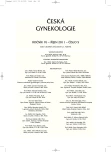Single embryo transfer – possibilities and limits
Authors:
V. Paseková; T. Mardešić; J. Vobořil; Š. Vilímová; V. Jelínková
Authors‘ workplace:
Sanatorium Pronatal, Praha, vedoucí lékař doc. MUDr. T. Mardešić, CSc.
Published in:
Ceska Gynekol 2011; 76(5): 397-400
Overview
Objective:
To evaluate the results of single embryo transfers, on a set of patients, for a given period of time.
Design:
Retrospective study.
Setting:
Pronatal Sanatorium, Prague.
Methods:
Between January 2008 and May 2010, we evaluated the results of all cycles with single embryo transfers in our workplace. There were four groups of patients: the first group with elective single embryo transfers (ESET, n=147), the second group with only a single embryo transfer without selection (SET n=269), the third group with transfer of one embryo derived from the native cycle (NC, n=70) and the last group with transfer of only one embryo examinated by preimplantation genetic diagnosis (PGD, n=104). All patients were monitored by age, length of cultivation of embryos, clinical pregnancy rate / transfer (CPR / ET), pregnancy loss (AB) and baby take home rate (BTR). Statistical evaluation was performed using the chi square test.
Results:
The group with ESET achieved a significantly higher success rate (50% CPR / ET, p <0.001) compared to the other groups: 22% for SET, 7% of spontaneous cycles and 18% after PGD. A significant difference (p <0.001) was also apparent in the evaluation of BTR: ESET 41%, 16% SET, NC 4%, 12.5% of PGD. Patients that made ESET were significantly younger (p <0.001) compared to the other monitored groups (32.9 ESET, SET 35.2, NC 39.6, 39.1 PGD).
Conclusion:
We consider that assisted reproduction is only successful with the birth of one healthy child. For women 38 years old or younger the most successful treatment is to transfer a single high quality embryo and to therefore eliminate multiple pregnancy. The age of a woman and the quality of the embryo are major prognostic factors.
Key words:
single embryo transfer, elective embryo transfer, multiple pregnancy.
Sources
1. Bechoua, S., Astruc, K., Thouvenot, S., et al. How to demonstrate that eSET does not compromise the likelihood of having a baby? Hum Reprod, 2009, 24(12), p. 3073-3081. Epub 2009 Sep 13.
2. Bensdorp, AJ., Slappendel, E., Koks, C., et al. The INeS study: prevention of multiple pregnancies: a randomised controlled trial comparing IUI COH versus IVF e SET versus MNC IVF in couples with unexplained or mild male subfertility. BMC Womens Health, 2009, 18, 9, p. 35.
3. Gerris, J. Single-embryo transfer versus multiple-embryo transfer. Reprod Biomed Online, 2009,18, Suppl 2: p. 63-70.
4. Leese, B., Denton, J. Attitudes towards single embryo transfer, twin and higher order pregnancies in patients undergoing infertility treatment: a review. Hum Fertil (Camb), 2010, 13(1), p. 28-34.
5. Luke, B., Brown, MB., Grainger, DA., et al. Society for Assisted Reproductive Technology Writing Group. Practice patterns and outcomes with the use of single embryo transfer in the United States. Fertil Steril, 2010, 93(2), p. 490-498. Epub 2009 Apr 18.
6. Min, JK., Hughes, E., Young, D., et al. Joint Society of Obstetricians and Gynaecologists of Canada-Canadian Fertility and Andrology Society Clinical Practice Guidelines Committee. Elective single embryo transfer following in vitro fertilization. J Obstet Gynaecol Can, 2010, 32(4), p. 363-377.
7. Pandian, Z., Templeton, A., Serour, G., Siladitya, B. Number of embryos for transfer after IVF and ICSI: a Cochrane review. Hum Reprod, 2005, 20, 10, p. 2681-2687.
8. Pelinck, MJ., Vogel, NEA., Hoek, A., et al. Minimal stimulation IVF with late folicular phase administration of the GnRH antagonist cetrorelix and concomitant substitution with recombinant FSH: a pilot study. Hum Reprod 2005, 20, p. 642-648.
9. Svobodová, M., Březinová, J., Oborná, I., et al. Prevence vícečetného těhotenství po metodě IVF/ICSI elektivním transferem jednoho embrya - pilotní studie. Čes Gynek, 2005, 70, 5, s. 343-347.
Labels
Paediatric gynaecology Gynaecology and obstetrics Reproduction medicineArticle was published in
Czech Gynaecology

2011 Issue 5
Most read in this issue
- Fetal hypotrophy dopplerometry
- Current classification of malignant tumours in gynecological oncology – part II
- Single embryo transfer – possibilities and limits
- Perineal audit: reasons for more than one thousand episiotomies
